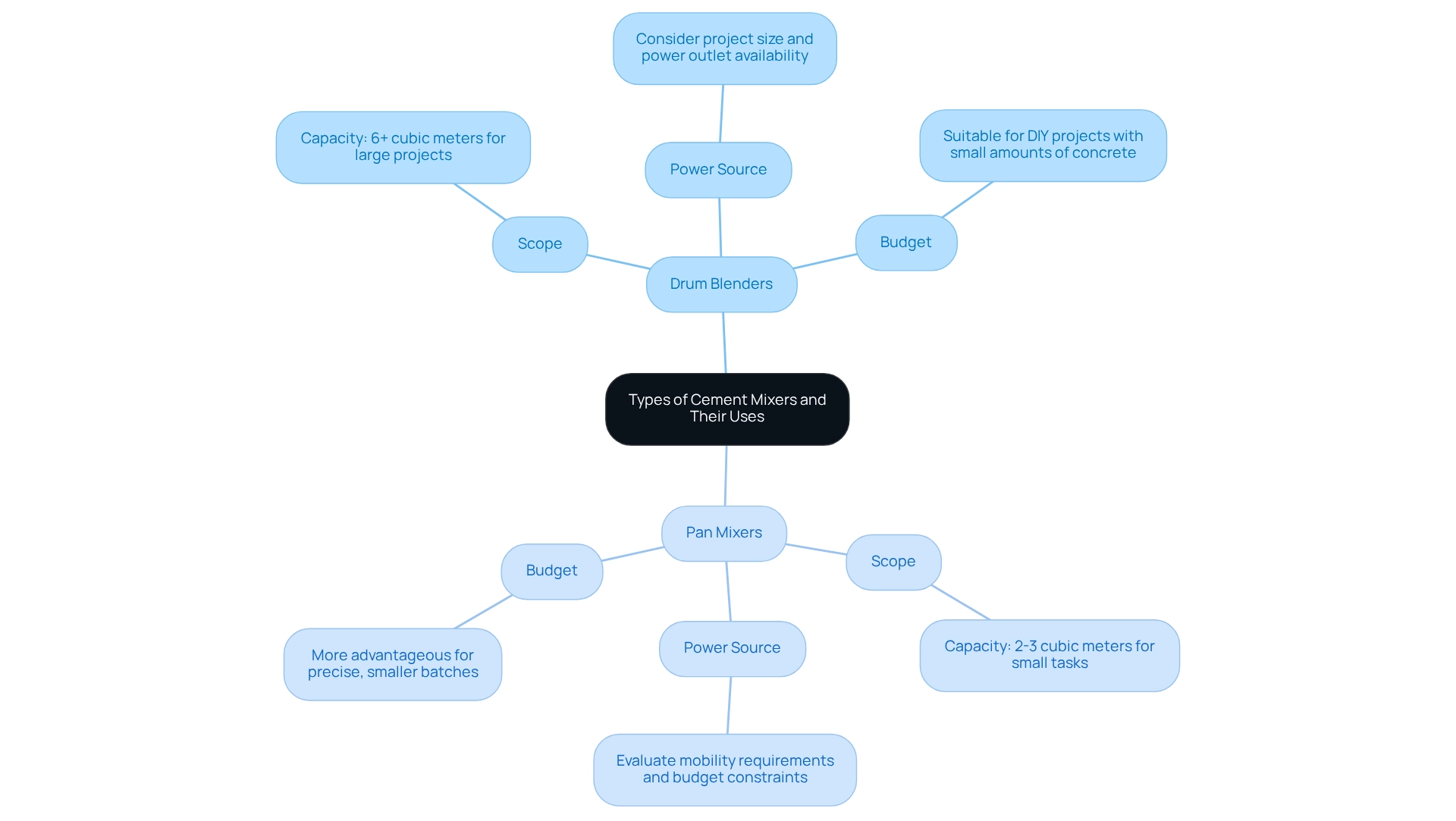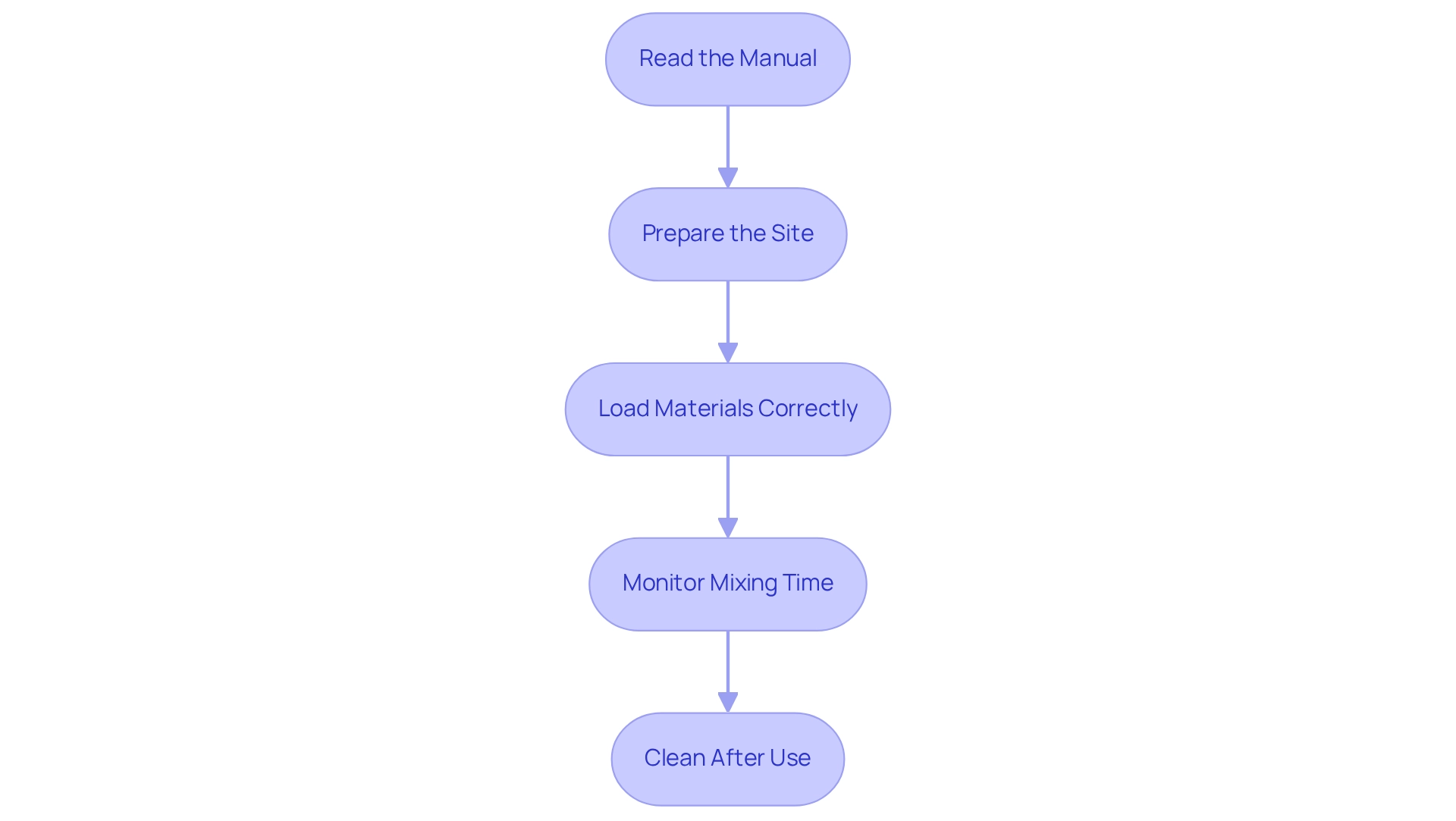Overview
This article delineates four essential practices for renting a cement mixer.
- Assess project requirements to ensure the right equipment is selected.
- Understand the various types of mixers available for making informed decisions.
- Compare rental options for cost-effectiveness, analyzing not just the upfront costs but also any hidden fees that may arise.
- Implement best practices for efficient operation to enhance productivity and ensure safety during use.
Each practice is supported by detailed advice, such as evaluating project needs, identifying suitable mixers, and following operational guidelines to maximize efficiency.
Key Highlights:
- Assess project requirements by determining the scope of work and site conditions to select the appropriate cement mixer.
- Utilize professional support from rental companies like EZ Equipment Rental for expert guidance in equipment selection.
- Understand industry trends, as the equipment leasing sector is projected to grow at a CAGR of 4.9% until 2025.
- Prioritize safety during operation to prevent accidents and ensure project success.
- Different types of mixers include drum blenders for large batches and pan mixers for smaller, precise tasks.
- Evaluate budget constraints and consider hidden fees when comparing rental options for cost-effectiveness.
- Implement best practices such as reading the manual, preparing the site, loading materials correctly, monitoring mixing time, and cleaning after use to optimize mixer operation.
- Following best practices can enhance productivity, with some contractors reporting up to a 20% increase in output.
Introduction
In the realm of construction, selecting the right equipment is pivotal to the success of any project. As construction tasks grow increasingly complex and the variety of cement mixers expands, understanding how to choose and operate the appropriate machinery becomes essential.
This article explores the key considerations for renting cement mixers, including:
- Assessing project requirements
- Understanding different mixer types
- Comparing rental options for cost-effectiveness
Furthermore, we will discuss best practices for efficient operation. By adhering to these guidelines, contractors and DIY enthusiasts can ensure their projects proceed smoothly and efficiently, ultimately leading to superior results.
Assess Project Requirements Before Renting
Assess Project Requirements Before Renting
- Determine Scope of Work: Begin by evaluating the scale of your project and the quantity of concrete required. For smaller residential tasks, a portable mixer may suffice, while larger commercial endeavors typically demand a robust, industrial-grade machine.
- Evaluate Site Conditions: Analyze site conditions, including accessibility and available space, to identify the appropriate mixer size and type. This comprehensive assessment is vital for selecting the right equipment and minimizing the risk of costly errors.
- Utilize Professional Support: With EZ Equipment Rental's commitment to reliability and exceptional customer service, you can expect expert assistance throughout the leasing process. Our team is dedicated to helping you choose the right equipment for your needs, ultimately enhancing the success of your project.
- Comprehend Sector Trends: As the equipment leasing industry is projected to grow at a CAGR of 4.9% until 2025, understanding these trends is increasingly essential for achieving successful outcomes. Embracing new experiences and learning from past rentals can further refine your ability to assess requirements effectively.
- Prioritize Safety: Remember, working safely is as vital as breathing—neglecting it can lead to dire consequences. Therefore, proper assessment plays a crucial role in ensuring safety and the successful execution of your project.

Understand Types of Cement Mixers and Their Uses
Cement machines, such as a cement mixer for hire, are indispensable tools in the construction industry, available in various types, each specifically designed for distinct applications. The primary categories include:
- Drum Blenders: These machines are designed for large batches of cement, utilizing a rotating drum to blend materials efficiently. They are ideal for significant construction projects where volume is paramount.
- Pan Mixers: Tailored for smaller batches, pan mixers excel in producing a mixture with a consistent texture. Their design facilitates effective blending, making them perfect for tasks that require precision, especially when utilizing a cement mixer for hire.
- Scope: For minor tasks, a concrete machine with a capacity of 2-3 cubic meters suffices, while larger projects may necessitate machines with capacities of 6 cubic meters or more.
- Power Source: According to industry expert Samson Adebowale, when choosing the energy source for your cement machine, consider factors such as the scale of your tasks, availability of power outlets, mobility requirements, and budget constraints.
- Evaluating your budget is crucial, as it significantly influences your choice of a cement mixer for hire and helps in selecting the appropriate blending device based on your project's scale and requirements. For instance, a drum blender may suffice for a DIY project involving a small amount of concrete, while a pan mixer would be more advantageous for smaller, precise batches. Industry insights suggest that larger capacity cement trucks are more suitable for extensive construction endeavors, ensuring that the right equipment aligns with project needs. A recent case study on selecting cement machines highlighted key considerations, including capacity, power source, durability, and budget. By taking these elements into account, you can make informed decisions that enhance both project efficiency and effectiveness.

Compare Rental Options for Cost-Effectiveness
When considering a cement mixer for hire, it is crucial to compare various options to achieve cost-effectiveness. Start by exploring local leasing companies, such as EZ Equipment Leasing at 1307 W Airport Fwy, Irving, TX. This company is recognized for its commitment to quality and reliability in the DFW Metroplex. They provide a wide range of equipment, including boom lifts, excavators, and forklifts, essential for your construction projects. Evaluate their rates, leasing terms, and included services carefully. Pay close attention to potential hidden fees, such as delivery charges or insurance costs, which can significantly affect the overall leasing price; studies indicate that these concealed costs can accumulate rapidly.
Additionally, consider the length of your lease, as many companies offer discounts for extended usage periods. For example, if you plan to use the mixer for a week, it’s wise to compare weekly rates against daily rates to optimize your savings. Weekly rental rates for larger equipment at EZ Equipment Rental can range from $2,000 to over $3,000, providing a benchmark for your budget. By conducting a thorough comparison of options, you can make an informed decision that aligns with your budget and project needs.
Implement Best Practices for Efficient Mixer Operation
To maximize the efficiency of your rented cement machine, adhere to the following best practices:
- Read the Manual: Before using the appliance, thoroughly review the manufacturer's instructions and safety guidelines to ensure proper use and compliance.
- Prepare the Site: Position the mixing device on a stable, level surface to prevent tipping and ensure even blending, which is essential for achieving optimal results.
- Load Materials Correctly: Begin by adding water, followed by dry materials. This sequence helps prevent clumping and promotes a smooth, consistent mix.
- Monitor Mixing Time: Avoid over-mixing, as this can compromise the quality of the mixture. Generally, a mixing duration of 3-5 minutes is adequate for achieving a well-blended mixture.
- Clean After Use: Following each use, thoroughly cleanse the device to remove material accumulation, which can obstruct future operations and influence performance.
Adopting these practices not only improves the efficiency of your mixing process but also guarantees a high-quality output, aligning with industry standards. Remarkably, contractors have indicated considerable enhancements in productivity; for example, one Texas construction firm observed a 20% rise in output after transitioning to a device with a hybrid-steel composition. Additionally, concrete mixers can significantly speed up construction processes for tasks like paving a driveway or expanding a house. By following these guidelines, you can optimize your equipment rental experience, especially with a cement mixer for hire, and achieve superior results in your construction projects. For more information and to reserve your equipment, contact EZ Equipment Rental at (214) 951-7800.

Conclusion
Selecting the right cement mixer is crucial for the success of any construction project. A thorough assessment of project requirements, including scale and site conditions, is essential to determine the appropriate mixer type. Understanding the different types of cement mixers—such as drum, pan, and vertical shaft mixers—enables contractors to select equipment that aligns with specific project needs.
Cost-effectiveness in rental options cannot be overlooked. By comparing various rental companies and their rates, including potential hidden fees, it becomes easier to make a budget-conscious choice. Furthermore, implementing best practices for mixer operation, from proper loading techniques to regular maintenance, enhances efficiency and ensures high-quality concrete output.
In summary, careful planning and informed decision-making regarding equipment rental can significantly impact project outcomes. By prioritizing these considerations, contractors and DIY enthusiasts alike can navigate the complexities of cement mixer rentals, leading to successful and efficient construction projects. Embracing these guidelines not only facilitates smooth operations but also fosters superior results that stand the test of time.
Frequently Asked Questions
What is the first step in assessing project requirements before renting equipment?
The first step is to determine the scope of work by evaluating the scale of your project and the quantity of concrete required. Smaller residential tasks may only need a portable mixer, while larger commercial projects typically require a robust, industrial-grade machine.
Why is it important to evaluate site conditions before renting equipment?
Evaluating site conditions is important to analyze accessibility and available space, which helps identify the appropriate mixer size and type. This comprehensive assessment minimizes the risk of costly errors.
How can professional support assist in the equipment rental process?
Professional support, such as that provided by EZ Equipment Rental, offers expert assistance throughout the leasing process, helping you choose the right equipment for your needs and enhancing the success of your project.
What trends should be understood when renting equipment?
It is essential to comprehend sector trends, as the equipment leasing industry is projected to grow at a CAGR of 4.9% until 2025. Understanding these trends can help achieve successful outcomes and refine your ability to assess requirements effectively.
Why is prioritizing safety crucial in project execution?
Prioritizing safety is crucial because neglecting it can lead to dire consequences. Proper assessment plays a vital role in ensuring safety and the successful execution of your project.




